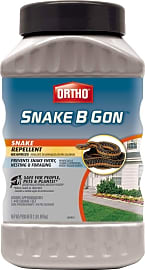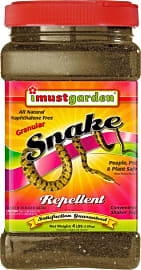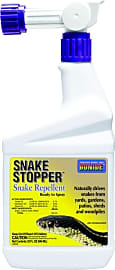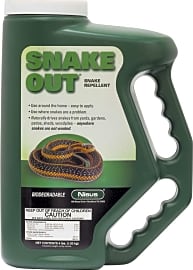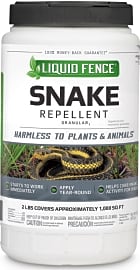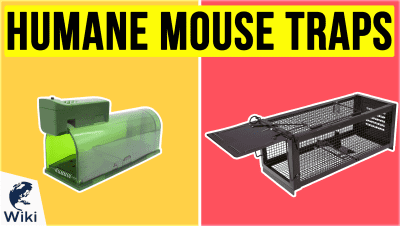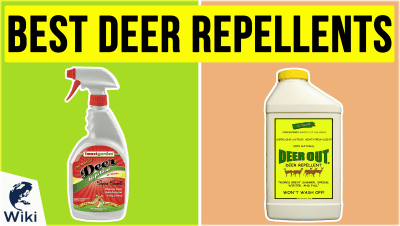The 10 Best Snake Repellents

This wiki has been updated 37 times since it was first published in April of 2016. We know snakes are a vital part of our glorious ecosystem, and we certainly wouldn't hope to harm any, but that doesn't mean we want them crawling all over our back garden. If you're tired of encountering slithery critters on your property, try one of these repellents. Just be sure to read the ingredients first, as some may contain chemicals that aren't suitable for use around kids and pets. When users buy our independently chosen editorial selections, we may earn commissions to help fund the Wiki.
Editor's Notes
October 04, 2020:
If can certainly be startling to encounter a snake slithering across your path as you are tending your garden, even if it happens to be a non-venomous variety. To help you rid your grounds of those uninvited slithering guests, we have found the best snake repellents, many of which utilize all-natural formulas to interfere with their senses.
We generally favor chemical-free products when possible, so nearly ever option this list makes uses of essential oils to repel snakes. That being said, we do realize that for some, an all-natural formula may not produce the results they need. For those people, we have included Dr. T's Snake-A-Way, which contains naphthalene. Because of this, it should not be used around pets or children, or in enclosed areas, like sheds, garages, and crawlspaces. It can also be a smart idea to wear a [respirator](naphthalene ) when applying it to your grounds.
If you don't want to deal with frequent reapplications, you should consider Nature's Mace SNKGN, which is touted to last as long as four months, thanks to a time-released formula. Though it is made from natural ingredients like cedar, citronella, thyme, and rosemary oils, and isn't harmful, some may still prefer not to use a granular product, since it can take time to dissolve and there is more chance that kids or pets may come into contact with it. If you are in this group and don't mind having to reapply the repellent every month, you may prefer Serpent Guard or Snake Defense instead, both of which are sprays.
It is worth noting that snakes generally inhabit regions that meet all of their needs, which includes fresh water and a food source. That food source is often rodents, so a good strategy for keeping serpents off your property is to combine the use of one of the snake repellents we have selected with effective mouse traps, since eliminating their food source may naturally motivate them to move on to other grounds.
April 18, 2019:
Removed the Vensmile VS-312S Solar because there's little evidence that sonic vibrations actually deter animals — and in some cases it might even attract them.
We went back and forth as to whether or not to include Dr. T's Snake-A-Way. On the one hand, it's an effective solution, especially against rattlesnakes. On the other, though, it contains naphthalene, a compound that could be hazardous to animals and humans. Ultimately, we decided that there are likely users who have a need for an effective snake repellent and don't have pets or small children around to interact with the granules. So, be aware before you buy it that, while it should be helpful, it's not something you want to touch, breathe in, or allow others to come in contact with.
That underscores a basic consideration that many users will have to take into account before making a purchase: whether they're willing to sacrifice some effectiveness in the interests of safety. This can affect everything from the type of repellent used (granules are usually longer-lasting than liquids, but they also provide more opportunities for pets or children to come in contact with them) to the areas in which it is applied (some are OK for in-home use, but these are naturally less powerful than their outside-only brethren). We can't make that decision for you, so it will ultimately come down to whether you think the snakes pose a bigger risk than the repellents.
Choosing An Effective Snake Repellent
The first involves using specially formulated solutions and/or pellets that repel the reptiles by creating an odor they can't tolerate.
If your property is subject to frequent visits by unwanted snakes, or if the reptiles have taken up residence there, it's likely that ridding the yard of these serpents will be at the top of your priority list. While most snakes pose little threat to adults, they can be an unsettling and unpleasant sight, and they can pose a greater danger to small children, pets, and to the other animals whose presence you welcome in your yard.
There are essentially two approaches to repelling snakes from your property. The first involves using specially formulated solutions and/or pellets that repel the reptiles by creating an odor they can't tolerate. The second approach involves using devices that create ultrasonic frequencies that snakes find so bothersome that they will slither away from the source.
When choosing the right snake repellent, you should first try to assess whether the reptiles are nesting in your yard or simply entering and exiting it as they forage for food, water, or for basking spots. If they are nesting on your property, you will need to spread much more repellent all over the property; if they are simply entering and exiting or are using your yard as a path between other areas, you may be able to simply pour thick borders of repellent. Look for a long-lasting formula if you plan to create a perimeter, as these repellents can help to "train" snakes away from the area.
While the scents used in most snake repellent formulas is not repulsive to most humans, some people may find the odors unpleasant, and they may bother pets and welcomed wild animals.
Ultrasonic snake repellents offer several bonuses over odor based options. First, they can be easily installed, removed, or relocated within a matter of minutes, if not seconds, allowing you to actively try various arrangements to see which setup is most effective. Some of these repellers also emit light from LED bulbs which can help to scare off snakes. The drawbacks are that these lights may annoy humans as well, and the sound waves might upset pets and other animals who were not the object of concern.
For the property suffering from large or deeply entrenched snake infestations, the best method of dealing with the issue might be a two pronged approach. By installing ultrasonic devices that will compile snakes to leave and by creating a scent barrier the animals will be unlikely to cross, you can better ensure that you will drive snakes away and then prevent them from returning.
Removing Serpent Attractions
Beyond merely establishing an olfactory barrier that snakes will be hesitant to cross or installing aural deterrent features in and around your property, one of the crucial steps you must take to reducing snake encounters on your property is to make your property less attractive to snakes in the first place. After all, you don't have to deal with the infestation that never takes place, and the less welcoming your yard is to snakes, the fewer you will have to deal with.
Snakes will seek cool interior areas in the heat of the summer and warm spaces when it's colder out; you don't want these comfort zones to be inside your property.
Often a snake problem starts with a rodent problem, these small creatures being the best food source for many serpents. If you take steps to repel rodents, you will likely repel snakes at the same time. There are both scent-based and mechanical options that can help with this.
Snakes always seek dark, safe places for shelter, so make sure your yard is free of these hideaway. Lumber, plywood, roofing material, or stacked wood can all create a haven for snakes, so remove these ready built shelter areas. Snakes seek shallow pools of water for hydration, so try to minimize these as well.
Simple landscaping steps like keeping grass mowed low and keeping the areas under hedges and around trees clear of overgrown foliage can also deprive snakes of the type of terrain they favor, thereby making them less likely to frequent your yard. And make sure to patch any holes in your house, garage, or shed, and to cover areas you need open with screens and/or vents. Snakes will seek cool interior areas in the heat of the summer and warm spaces when it's colder out; you don't want these comfort zones to be inside your property.
A Brief Look At Snakes In America
Despite the fear the thought of a snake can induce, in America, there are few annual encounters between humans and snakes that lead to bites, and only a minute number of these lead to serious health complications or death. There are four major species of venomous (the correct term, though poisonous is often used) snakes in America. These are the rattlesnake, moccasin, copperhead, and coral snake. There are many subspecies of snake within each of these categories, including nearly two dozen types of rattlesnake alone, but those are the major groups for which a person must watch out.
These are the rattlesnake, moccasin, copperhead, and coral snake.
Far more numerous than these venomous snakes, however, are their non-venomous counterparts. In the colubrideae family, for example, there are more than one hundred specific subspecies of serpent to be found in North America, and none of them poses a significant threat to an adult human. This is the family that includes black snakes and garter snakes, which may well cause more good than harm, keeping rodent and insect populations at bay.
There are only two species of boidae snakes (boa constrictors, e.g.) native to America, though there is a massive and growing problem of invasive Burmese pythons now spreading throughout much of the south east. These nonnative snakes have taken root mostly after being turned out of captivity. The former "pets" can reach a staggering sixteen feet in length in the wild and are a major threat to local flora and faunae.





